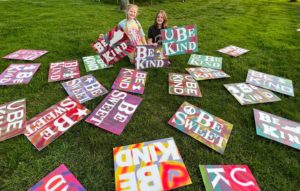In the summer of 2019, two young sisters set out to spread kindness around their small county in Kentucky. They created “Be Kind” yard signs and sold them to local neighbors and merchants who proudly display them in their front yards and businesses. Money raised by selling the signs has been donated to a local charity that supports services for families with children living with Down’s Syndrome. Today, Oldham County is blanketed with hundreds of signs reminding residents and workers “the importance of being gentle, generous, and charitable.”[1] (image below: Be Kind Sisters Facebook page)
 Living kindly – Being Kind – is more than a trending sentiment. It’s a spiritual practice. Paul includes “kindness” in his list of fruits of the spirit (Gal 5:22). Merriam-Webster.com defines “Kind” as being of a sympathetic or helpful nature; of forbearing nature, gentle; arising from or characterized by sympathy or forbearance.[2] Kindness is a value we hope our children embrace.
Living kindly – Being Kind – is more than a trending sentiment. It’s a spiritual practice. Paul includes “kindness” in his list of fruits of the spirit (Gal 5:22). Merriam-Webster.com defines “Kind” as being of a sympathetic or helpful nature; of forbearing nature, gentle; arising from or characterized by sympathy or forbearance.[2] Kindness is a value we hope our children embrace.
“Be Kind” is a character trait that can be modeled, inspired, and developed. Tweens and teens are able to see, assess, and commit to being kind as a posture they embrace for themselves and exhibit toward others. Try these simple activities to encourage young people to Be Kind.
Be Kind: A Simple Lesson Plan
Select activities appropriate to the age level of your group: tween, young teens, or older teens. Some activities can be adjusted to involve a broadly-graded range of young people.
Arrival: That Kind of Week
Gather in a circle and give each person the opportunity to check in, telling one another about what kind of week they had. Encourage them to briefly talk about a high point and a low point from the past week. Have each person conclude sharing by saying, “It’s been that kind of week.”
Setting the Theme: Talking About Kindness
Choose one or both options.
1) Form teams of 2-3 young people. Have teams talk briefly about being kind and how to describe kindness. Gather the group and have each team share one description of kindness or being kind. Move from group to group, with each team sharing a unique description until all of their ideas are shared.
Explain that the theme for this gathering is “Be Kind” and they will consider and discover ways to be kind in their daily lives.
2) Form teams of 2-3 youth. Distribute paper and pens. Assign each team a letter from the phrase, “Be Kind.” Teams are to identify words that describe kindness that begin with their assigned letter. Write down their words. Gather the group and have teams read aloud their list. Talk about the value of kindness for ourselves and others.
In the Bible
Use Bibles or refer youth to a Bible app for smartphones (bible.oremus.org or biblegateway.com)
Micah 6:6-8; Galatians 5:22-23; Matthew 25:34-40
Determine which of these texts you will study; you may use all three suggestions. Have youth read the selected text. If you use more than one passage, form small groups and have each group read a different passage. Use these questions to discuss the passage(s).
- What do these verses say about kindness? What do you think the biblical writer wanted readers to understand when they wrote this passage?
- How important is kindness in relation to the other qualities presented in the passage?
- How can you learn about being kind even when a passage doesn’t include the word kind or kindness?
- After reading these texts, what does the Bible say to you about kindness and being kind?
Extra Challenge: A biblical call to kindness moves deeper than surface-level niceties. How can the intention to “Be Kind” move beyond superficial actions? Also, consider the careful balance needed when we commit to “Be Kind” while not opening ourselves to being taken advantage of or being hurt.
Seeing Kindness
Choose one or both options.
1) As a group, discuss what kindness looks like.
- What traits or actions do you see when someone is being kind?
- What might you see in a church or school that shows kindness?
- How might a community show kindness in concrete ways?
2) Use a smartphone or internet-connected device to view an HGTV.com video “How Richins Sisters Turned Hometown Into Kindness Capital of Kentucky | PEOPLE.com” (2:28 min). You may also read the People.com article that accompanies the video. Discuss as a group:
- How did the sisters take something they saw and turn it into a project for others to see?
- What is the effect of seeing Be Kind signs posted across a community?
- How might seeing a simple sign remind people to Be Kind?
Do Something
Choose one or more options.
1) Take a walk. Use paper and pen or a smartphone. As a group or in pairs, take a walk throughout your church building. Note concrete examples of kindness, either in the interactions you see between people or the concrete messages and facilities that communicate kindness to others. Record what is seen. Return to your learning space and share what was seen. How can you celebrate the way your church is kind? How can you encourage kindness in your church?
2) Walk your neighborhood. Use instructions for option 1 but take a walk around the neighborhood where you regularly gather. Identify examples of kindness that are seen. For an extra challenge, encourage young people to identify suggestions or changes that could enhance kindness in the neighborhood.
3) Graffiti Wall. Use a whiteboard/chalkboard/newsprint and writing tools to create a graffiti wall. Write “Be Kind” in large letters in the middle of the writing surface. Have young people write messages of kindness. They may also name examples of kindness that have been discussed in this session. Display the graffiti wall to share kindness with others.
4) “Be Kind” Signs. Brainstorm ideas for reminding people to Be Kind. Young people could paint rocks, make buttons, bookmarks, posters, yard signs, or a mural. They could leave post-it notes inside hymnbooks or Bibles in the sanctuary. As a group, make concrete plans to create “Be Kind” signs during this session or at a later session.
5) Extra Challenge. Encourage young people to keep a journal during the coming week, making notes of daily opportunities to be kind or daily incidents that challenge their kindness. In their reflections, they may comment on their feelings, their responses, and the types of incidents that trigger different responses. Challenge them to identify (and use) reminders to be kind in their daily living. What types of reminders help them to Be Kind?
Closing
Invite each person to name one thing about kindness that they take away from this session. Encourage them to seek out one act of kindness that they can offer in the coming week.
Form a circle and have young people join hands. Have them give and receive messages of kindness to one another. To the person on their left, say “Be Kind.” To the person on their right, say “Love Kindness.”
Let everyone say together, “Amen.”
Additional note for Simple Things: The Presbyterian Mission Agency’s Office of Christian Formation offers a number of Quicksheets with teaching tips, simple ideas, and lesson plans designed to quickly pick up and use. Just what many busy educators and youth leaders need! Check out their link.
____________
[1] “The ‘Be Kind’ Sisters,” bekindsigns.org
[2] “Kind,” merriam-webster.com/dictionary/kind

